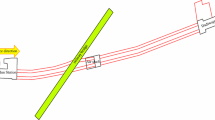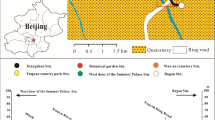Abstract
Soil conditioning is essential for addressing the stratum applicability problem of earth pressure balance (EPB) shields. Under high water pressures, EPB shields spew water and soil when excavating coarse-grained strata. Typically, foam combined with polymers and slurry is used to solve spewing. However, in current techniques, slurry, foam, and the other agents are mixed with soil separately, their synergistic effect is seldom realized. In this study, an anionic surfactant was used to foam in bentonite slurry to form bubble–slurry to maximize the synergy between bubbles and slurry. The slump, volume stability, and permeability test of bubble–slurry-conditioned sand was conducted to examine the conditioning effect, and the stratum applicability of bubble–slurry was determined from the perspective of permeability. It was found that the conditioning effect of bubble–slurry in coarse gravel soil was excellent and could expand the applicability of EPB shields. The main stabilization mechanism of bubble–slurry is that bentonite particles provide a space barrier for bubbles. And three seepage modes of bubble–slurry-conditioned sand were innovatively defined, and the occurrence conditions of the three seepage modes were analyzed according to the permeability coefficient of sand, initial dynamic shear force of bubble–slurry, and hydraulic gradient.
Similar content being viewed by others
References
Lei H Y, Zhang Y J, Hu Y, Liu Y N. Model test and discrete element method simulation of shield tunneling face stability in transparent clay. Frontiers of Structural and Civil Engineering, 2021, 15(1): 147–166
Liao S M, Liu J H, Wang R L, Li Z M. Shield tunneling and environment protection in Shanghai soft ground. Tunnelling and Underground Space Technology, 2009, 24(4): 454–465
Martinelli D, Peila D, Campa E. Feasibility study of tar sands conditioning for earth pressure balance tunnelling. Journal of Rock Mechanics and Geotechnical Engineering, 2015, 7(6): 684–690
Liu P F, Wang S Y, Ge L, Thewes M, Yang J S, Xia Y M. Changes of Atterberg limits and electrochemical behaviors of clays with dispersants as conditioning agents for EPB shield tunnelling. Tunnelling and Underground Space Technology, 2018, 73: 244–251
Wang L, Zhu W, Qian Y J, Xu C, Hu J N, Xing H T. Phenomenon and critical conditions of chamber soil sliming during EPB shield tunneling in water-rich weathered diorite: Case study of Jinan Metro, China. Advances in Civil Engineering, 2020, 2020: 1–15
Zheng G, Dai X, Diao Y. Parameter analysis of water flow during EPBS tunnelling and an evaluation method of spewing failure based on a simplified model. Engineering Failure Analysis, 2015, 58: 96–112
Merritt A S, Mair R J. Mechanics of tunnelling machine screw conveyors: Model tests. Geotechnique, 2006, 56(9): 605–615
Peila D. Soil conditioning for EPB shield tunnelling. KSCE Journal of Civil Engineering, 2014, 18(3): 831–836
Baghali H, Chakeri H, Sharghi M, Dias D. Effect of soil moisture and granulometry on soil conditioning for EPB-TBM tunneling: Case study. Journal of Testing and Evaluation, 2021, 49(1): 355–371
Peila D, Oggeri C, Borio L. Using the slump test to assess the behavior of conditioned soil for EPB tunneling. Environmental & Engineering Geoscience, 2009, 15(3): 167–174
Vinai R, Oggeri C, Peila D. Soil conditioning of sand for EPB applications: A laboratory research. Tunnelling and Underground Space Technology, 2008, 23(3): 308–317
Budach C, Thewes M. Application ranges of EPB shields in coarse ground based on laboratory research. Tunnelling and Underground Space Technology, 2015, 50: 296–304
Galli M, Thewes M. Rheological characterisation of foam-conditioned sands in EPB tunneling. International Journal of Civil Engineering, 2019, 17(1): 145–160
Langmaack L, Lee K F. Difficult ground conditions? Use the right chemicals! Chances-limits-requirements. Tunnelling and Underground Space Technology, 2016, 57: 112–121
Quebaud S, Sibai M, Henry J P. Use of chemical foam for improvements in drilling by earth-pressure balanced shields in granular soils. Tunnelling and Underground Space Technology, 1998, 13(2): 173–180
Tao L M, Chen Z T, Cui J, Wang H W, Fang Y. Experimental methods to assess the effectiveness of soil conditioning with foam in fully weathered granite. Advances in Materials Science and Engineering, 2019, 2019: 1–12
Wan Z E, Li S C, Yuan C, Zhao S S, Wang M L, Lu Q L, Hou W. Soil conditioning for EPB shield tunneling in silty clay and weathered mudstone. International Journal of Geomechanics, 2021, 21(9): 06021020
Wu Y L, Mooney M A, Cha M S. An experimental examination of foam stability under pressure for EPB TBM tunneling. Tunnelling and Underground Space Technology, 2018, 77: 80–93
Hu Q X, Wang S Y, Qu T M, Xu T, Huang S, Wang H B. Effect of hydraulic gradient on the permeability characteristics of foam-conditioned sand for mechanized tunnelling. Tunnelling and Underground Space Technology, 2020, 99: 103377
Carigi A, Luciani A, Todaro C, Martinelli D, Peila D. Influence of conditioning on the behaviour of alluvial soils with cobbles. Tunnelling and Underground Space Technology, 2020, 96: 103225
Selmi M, Kacem M, Jamei M, Dubujet P. Physical foam stability of loose sandy-clay: A porosity role in the conditioned soil. Water, Air, and Soil Pollution, 2020, 231(5): 251
Huang Z Q, Wang C, Dong J Y, Zhou J J, Yang J H, Li Y W. Conditioning experiment on sand and cobble soil for shield tunneling. Tunnelling and Underground Space Technology, 2019, 87: 187–194
Xu Q W, Zhang L Y, Zhu H H, Gong Z Y, Liu J G, Zhu Y H. Laboratory tests on conditioning the sandy cobble soil for EPB shield tunnelling and its field application. Tunnelling and Underground Space Technology, 2020, 105: 103512
Ling F, Wang S, Hu Q, Huang S, Feng Z. Effect of bentonite slurry on the function of foam for changing the permeability characteristics of sand under high hydraulic gradients. Canadian Geotechnical Journal, 2022, 59(7): 1061–1070
Borio L, Peila D. Study of the permeability of foam conditioned soils with laboratory tests. American Journal of Environmental Sciences, 2010, 6(4): 365–370
Kim T H, Kim B K, Lee K H, Lee I M. Soil conditioning of weathered granite soil used for EPB shield TBM: A laboratory scale study. KSCE Journal of Civil Engineering, 2019, 23(4): 1829–1838
Wang S, Huang S, Zhong J, Zhang S, Hu Q, Qu T, Ye X. Permeability stability calculation model of foam-conditioned soil based on the permeability constant. International Journal for Numerical and Analytical Methods in Geomechanics, 2021, 45(4): 540–559
Katagiri J, Kimura S, Noda S. Significance of shape factor on permeability anisotropy of sand: Representative elementary volume study for pore-scale analysis. Acta Geotechnica, 2020, 15(8): 2195–2203
Uma K O, Loehnert E P. Hydraulic conductivity of shallow sandy aquifers: Effects of sedimentologic and diagenetic differences. Environmental Geology, 1994, 23(3): 171–181
Yu L, Han Z, He J, Li G. Experimental study on the permeability damage mechanism of gravel pack sand control medium in mud hydrate reservoirs. Journal of Coastal Research, 2022, 38(6): 1104–1115
Jauregi P, Gilmour S, Varley J. Characterisation of colloidal gas aphrons for subsequent use for protein recovery. Chemical Engineering Journal, 1997, 65(1): 1–11
Molaei A, Waters K E. Aphron applications—A review of recent and current research. Advances in Colloid and Interface Science, 2015, 216: 36–54
Sun Q, Li Z M, Wang J Q, Li S Y, Li B F, Jiang L, Wang H Y, Lu Q C, Zhang C, Liu W. Aqueous foam stabilized by partially hydrophobic nanoparticles in the presence of surfactant. Colloids and Surfaces A: Physicochemical and Engineering Aspects, 2015, 471: 54–64
EFNARC. Specifications and Guidelines for the Use of Specialist Products for Mechanized Tunnelling (TBM) in Soft Ground and Hard Rock. Surrey: EFNARC, 2005
Min F L, Song H B, Zhang N. Experimental study on fluid properties of slurry and its influence on slurry infiltration in sand stratum. Applied Clay Science, 2018, 161: 64–69
ASTM C143/C143M-20. Standard Test Method for Slump of Hydraulic-Cement Concrete. West Conshohocken: ASTM International, 2020
ASTM D2434-22. Standard Test Methods for Measurement of Hydraulic Conductivity of Coarse-Grained Soils. West Consho-hocken: ASTM International, 2022
Zhao G, Dai C L, Wen D L, Fang J C. Stability mechanism of a novel three-phase foam by adding dispersed particle gel. Colloids and Surfaces A: Physicochemical and Engineering Aspects, 2016, 497: 214–224
Zhong X, Liu D X, Shi X F, Zhao H T, Pei C, Zhu T Y, Shao M L, Zhang F. Characteristics and functional mechanisms of clay- cement stabilized three-phase nitrogen foam for heavy oil reservoir. Journal of Petroleum Science Engineering, 2018, 170: 497–506
Wang H, Wang S, Zhong J, Qu T, Liu Z, Xu T, Liu P. Undrained compressibility characteristics and pore pressure calculation model of foam-conditioned sand. Tunnelling and Underground Space Technology, 2021, 118: 104161
Zhong J, Wang S, Qu T. Undrained vane shear strength of sand-foam mixtures subjected to different shear rates. Journal of Rock Mechanics and Geotechnical Engineering, 2022, 15(6): 1591–1602
Zhang S Q, Pei H F. Determining the bound water content of montmorillonite from molecular simulations. Engineering Geology, 2021, 294: 106353
Carn F, Colin A, Pitois O, Vignes-Adler M, Backov R. Foam drainage in the presence of nanoparticle-surfactant mixtures. Langmuir, 2009, 25(14): 7847–7856
Jin H J, Zhou W Z, Cao J, Stoyanov S D, Blijdenstein T, de Groot P, Arnaudov L N, Pelan E G. Super stable foams stabilized by colloidal ethyl cellulose particles. Soft Matter, 2012, 8(7): 2194–2205
Wang T F, Fan H M, Yang W P, Meng Z. Stabilization mechanism of fly ash three-phase foam and its sealing capacity on fractured reservoirs. Fuel, 2020, 264: 116832
Zhao J, Torabi F, Yang J. The synergistic role of silica nanoparticle and anionic surfactant on the static and dynamic CO2 foam stability for enhanced heavy oil recovery: An experimental study. Fuel, 2021, 287: 119443
Binks B P. Particles as surfactants—Similarities and differences. Current Opinion in Colloid & Interface Science, 2002, 7(1–2): 21–41
Garbin V, Crocker J C, Stebe K J. Nanoparticles at fluid interfaces: Exploiting capping ligands to control adsorption, stability and dynamics. Journal of Colloid and Interface Science, 2012, 387(1): 1–11
Tzoumaki M V, Karefyllakis D, Moschakis T, Biliaderis C G, Scholten E. Aqueous foams stabilized by chitin nanocrystals. Soft Matter, 2015, 11(31): 6245–6253
Yekeen N, Manan M A, Idris A K, Padmanabhan E, Junin R, Samin A M, Gbadamosi A O, Oguamah I. A comprehensive review of experimental studies of nanoparticles-stabilized foam for enhanced oil recovery. Journal of Petroleum Science Engineering, 2018, 164: 43–74
Zhu W X, Zheng X H, Li G M. Micro-bubbles size, rheological and filtration characteristics of Colloidal Gas Aphron (CGA) drilling fluids for high temperature well: Role of attapulgite. Journal of Petroleum Science Engineering, 2020, 186: 106683
Acknowledgements
This study was funded by National Key R&D Program of China (2022YFC3202705), the Fundamental Research Funds for the Central Universities (B200203081), and the Postgraduate Research and Practice Innovation Program of Jiangsu Province (KYCX20_0436).
Author information
Authors and Affiliations
Corresponding author
Ethics declarations
Conflict of Interest The authors declare that they have no conflict of interest.
Rights and permissions
About this article
Cite this article
Wang, L., Zhu, W. & Qian, Y. Experimental study on the stratum applicability and mechanisms of bubble-slurry for earth pressure balance shields. Front. Struct. Civ. Eng. 17, 1387–1399 (2023). https://doi.org/10.1007/s11709-023-0005-y
Received:
Accepted:
Published:
Issue Date:
DOI: https://doi.org/10.1007/s11709-023-0005-y




